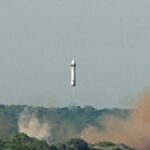Caldwell 65, better known as the Sculptor galaxy, is bursting with stellar activity and dust-rich features. Located 11 million light-years away—right next door in cosmological terms—it offers a rare glimpse of young stars being born into the celestial circle of life. Using the Very Large Telescope (VLT), astronomers captured an incredibly detailed image of the nearby spiral galaxy, displayed in thousands of colors that illuminate all the action taking place in our galactic neighborhood.
The European Southern Observatory (ESO) released a galaxy-wide image of the Sculptor galaxy on Wednesday, uncovering 500 planetary nebulae and zooming in on star-forming regions in a wide array of hues.
“Galaxies are incredibly complex systems that we are still struggling to understand,” explained ESO researcher Enrico Congiu in a statement. “The Sculptor Galaxy is in a sweet spot. It is close enough that we can resolve its internal structure and study its building blocks with incredible detail, but at the same time, big enough that we can still see it as a whole system.” Congiu is the lead author on the study, published today in Astronomy & Astrophysics.
Sculptor is one of the closest galaxies outside our local galactic neighborhood, making it an ideal target for observations that can help scientists peer into the internal structures of these massive cosmic beings. In order to create the most recent image of Sculptor, the researchers behind the new study stared at the galaxy for over 50 hours using VLT’s Multi Unit Spectroscopic Explorer. The team then stitched together more than 100 exposures, covering an area of the galaxy that stretches around 65,000 light-years wide.
Galaxies are made up of stars, gas, and dust, which emit light in different colors. Typically, snapshots of galaxies are seen in only a handful of colors. In this new image, Sculptor shines in thousands of different colors, each one telling a different part of its galactic story.
The image reveals regions that highlight specific wavelengths of light emitted by hydrogen, nitrogen, sulfur, and oxygen. The pink light, spread throughout the snapshot, comes from ionized hydrogen in star-forming regions, excited by radiation from newborn stars. The cone of white light at the center is caused by an outflow of gas from the black hole at the galaxy’s core.
“We can zoom in to study individual regions where stars form at nearly the scale of individual stars, but we can also zoom out to study the galaxy as a whole,” Kathryn Kreckel, a researcher at Heidelberg University, Germany, and co-author of the new study, said in a statement.
Initial analysis of the image uncovered hundreds of planetary nebulae in the Sculptor galaxy, a glowing shell of ionized gas left in the wake of dying stars like our Sun. “Beyond our galactic neighborhood, we usually deal with fewer than 100 detections per galaxy,” Fabian Scheuermann, a doctoral student at Heidelberg University and co-author of the study, said in a statement.
The team is planning on carrying out further analysis of the galactic map to explore the journey of gas within galaxies, and how it flows and changes composition to form newborn stars. “How such small processes can have such a big impact on a galaxy whose entire size is thousands of times bigger is still a mystery,” Congiu said.
Read the full article here










